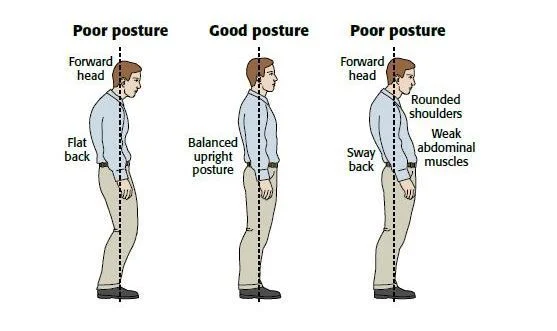It's not always simple to tell the difference between excellent and terrible posture. More than just being poised or self-assured, posture also refers to how you stand, sit, walk, sleep, and how well your body functions as a whole.
Proper body alignment, improved breathing, increased circulation, and the elimination of back discomfort are among the benefits of good posture.
Want to learn more about posture and how to improve it? Keep reading.
Regardless of whether they have weak muscles or not, most people automatically use their muscles to maintain a proper posture because it is a biological requirement for humans. It's actually pretty simple to make changes to one's posture that will benefit one's health and well-being.

Perfect Posture and Why It Matters?
Your body should be in a neutral position when sitting, standing, and walking. Proper body alignment promotes weight distribution, lessens pain and degeneration in the joints, and strengthens the muscles and ligaments.
Your general health as well as your body image and confidence depend on your posture.
Maintaining proper posture will relieve pressure on your back and shoulders and keep your bones and joints in their proper positions.
Slouching can reduce lung capacity, overstretch other muscles, shorten some muscles, and make it difficult to breathe. You can give your cardiovascular health a significant boost by correcting your body posture.
Due to imbalances and poor biomechanics, bad body position will have an impact on your back and abdominal muscles, ligaments, and tendons and place too much pressure on your back.

Inappropriate Posture and Why It IS Harmful For Health?
The list of negative consequences of poor posture is extremely extensive. Poor posture compromises health and general well-being in addition to the obvious negative effects. Among the effects of bad posture are:
Pain in the muscles
The effects of aberrant postures are particularly severe on the body's skeletal and muscular systems. Such positions frequently cause the vertebrae to mid-align, which results in pain in various spinal regions. Additionally, unnatural positions place the body's weight unevenly on its bones, muscles, and joints, which causes pain and soreness in the afflicted areas.
Increased risk of cardiovascular disease
Slouching and other instances of poor posture put more strain on the diaphragm, ribs, and lungs, which makes the heart work harder.
Additionally, bad posture along with a sedentary lifestyle narrows blood arteries, which impairs blood flow and increases the risk of circulatory abnormalities such as deep vein thrombosis.
Breathing problems
As was already noted, slouching puts more strain on the thorax and belly narrows the lungs, and reduces their capacity, which leads to inadequate air intake and decreased oxygenation.

Examples of Poor Posture
There are many different posture therapies available, but before beginning a treatment plan, you must identify the type of posture you have. Find out more about the many types below:
Kyphosis
The forward rounding of your spine is called kyphosis, and it is typical in senior women. The thoracic or middle back is where it is most noticeable. Long-term slouching, excessive sitting, heredity, damaged vertebrae, osteoporosis, disc degeneration, congenital impairments, and occasionally malignancy are some of the possible causes.
Kyphosis can cause chronic back discomfort, migraines, and poor upper body biomechanics.
Flatback
Your spine loses its natural curve and flattens out if you have a flat back. Degenerative disc disorders, compression fractures, lumbar post-laminectomy syndrome, or arthritis can all cause this posture to develop. Ironically, trying to maintain "excellent posture" without taking into account the natural curves of the spine might also cause this.
Swayback
The spine naturally curves inward in each of us. However, if the curve is excessive, it can lead to low back hyperlordosis, which is common in obese people and pregnant women. The hips moving forward to balance the spine position when standing is what eventually defines swayback.
A forward-facing posture
The upper cervical spine is hyper-extended when the chin protrudes forward, while the lower cervical spine is over-flexed.

Conclusion
Enhance your posture without effort!
Having good posture involves more than just how you stand or sit. In essence, our stance tells so lot about who we are. Not only does posture affect how we appear, but it also affects how we walk, sit, and stand.
Unfortunately, not everybody stands straight. Since so many of us have occupations that require us to spend a lot of time sitting in uncomfortable chairs, hunching over a keyboard, and staring at a computer screen, "perfect" posture is actually pretty rare.
Then, more of us return home and continue to spend extended periods of time staring at our smart devices, unknowingly acquiring poor posture. To determine the kind and severity of your posture before beginning any posture corrector therapies, evaluate your body alignment. If you're unsure, consult a physical therapist, or doctor.
Optimizing your health and spine alignment begins with becoming aware of your posture and how it impacts your body. If you or someone you love is suffering from this, you should consult expert physiotherapists to get rid of the strain.
Physiotherapists at fit o fine use cutting-edge advanced practices that include but are not limited to the use of massages, movements, and exercises. Make an appointment with us so that one of our therapists can discuss the best treatment option for you.
